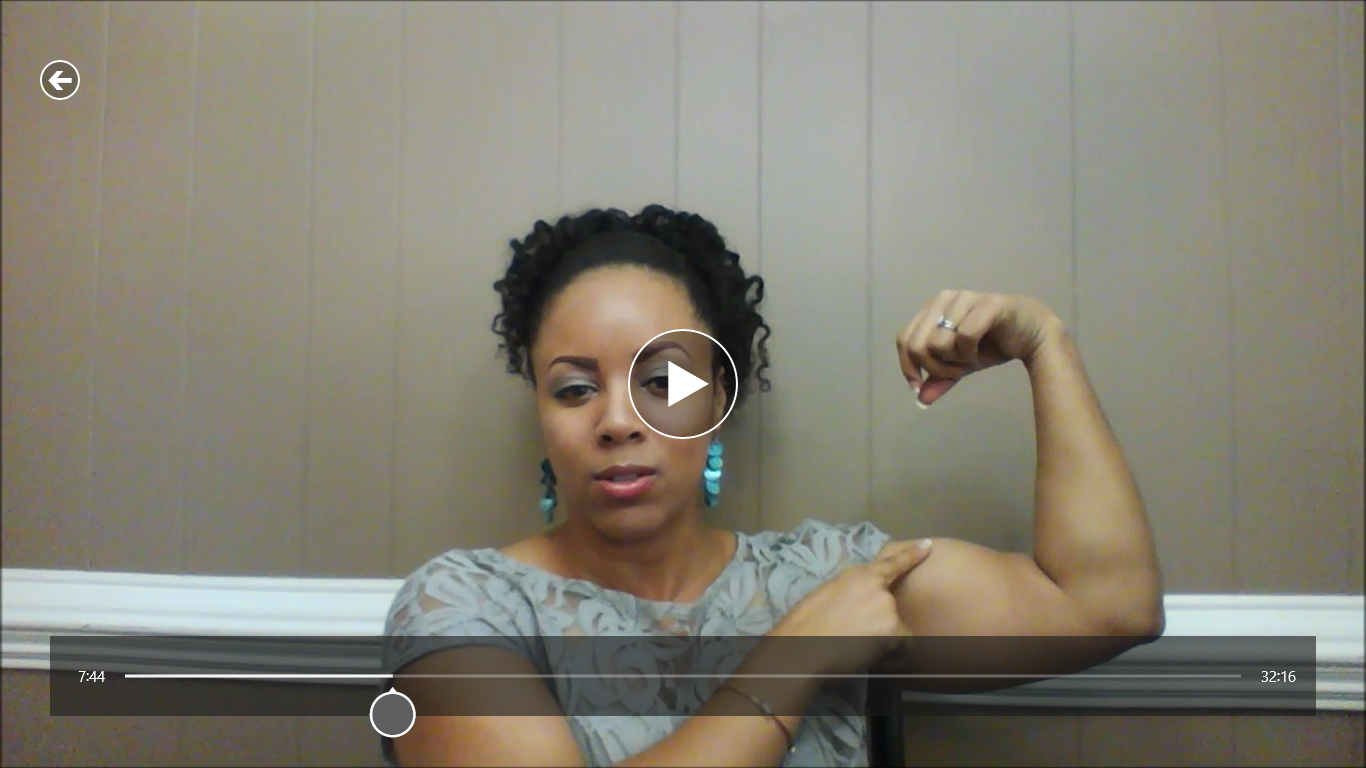
by EM2WL | Dec 18, 2014 | Strength Training, Videos
Which rep range is best for fat loss? Muscle building? General strength?
Weight lifting isn’t just about simply picking any workout on the internet, any DVD off the shelf, or any random dumbbell and doing any amount of reps you prefer. Every rep range performs a purpose, and it’s beneficial to hit them all at some point. The 3-part video series below breaks down the basics of the main three rep ranges of lifting: Strength, Hypertrophy, and Endurance.
Understanding the differences between them all can help you when putting together your own lifting program.
Video 1 discusses the Strength phase.
Strength is typically categorized as lifting as heavy as possible, for anywhere from 1-7 repetitions. Rest periods can be as short as 60 seconds if working opposing muscle groups (chest/back), or as long as 3-5 minutes. The lower the amount of reps, the longer the rest is required to replenish the muscles with the energy needed to hit it hard again at the same intensity level. Rest periods and all out effort are essential during this phase. Shortening the rest periods during true “strength” training phases typically is a sign of not pushing hard enough during the set, which essentially turns the workout into either a hypertrophic or endurance based one (phases discussed in next video).
Video 2 discusses the Hypertrophy and Endurance phases.
Hypertrophy is the phase used for adding size to the muscle. During this phase you are lifting as heavy as possible (meaning you can’t eek out any extra reps), for around 8-12 repetitions. Rest periods are usually 30-60 seconds, depending on if you are supersetting with opposing muscle groups (chest/back). Lower rest times are needed during supersets because one muscle is resting while the other is working.
Endurance is the phase that increases endurance of the smaller muscles, allowing the larger muscles to work at full capacity (without the smaller muscles failing) in the other phases. This phase is very cardiovascular in nature, with rest periods of 30 seconds or less. The higher the amount of reps, the less rest is required, so most circuit and DVD type workouts will fit into this phase category.
Video 3 discusses how the rep ranges come together for each individuals needs (periodization). When focusing on a particular goal, you will likely spend the majority of your time in the rep range that most directly corresponds to the end goal. However, you can still dip into other rep ranges as necessary in order to enhance the benefits of the other phases when you return to them. Try not to view any rep range as completely useless. When it comes to goals like fat loss and muscle building, periodization can be a key attribute in preventing plateaus by essentially sending your body through a faux “newbie gain” phase every time you return to your main rep range. Win, win!
I hope you enjoy this series, fam! Of course, all this info and more is included in our Beginner Strength Training Manual. 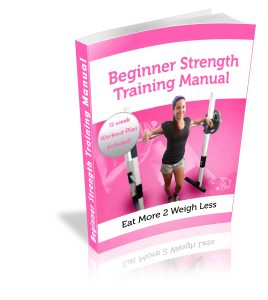
Let me know if this helps you…or if I just made it more confusing. LOL. If you have any other questions, or need more clarification (from this or any other vid/blog), drop me a line below!
~Kiki :)
SUBSCRIBE to our YouTube Channel for weekly info and motivation.

by Trish Adams | Dec 16, 2014 | Metabolism Reset, Strength Training, Testimonials, The Journey
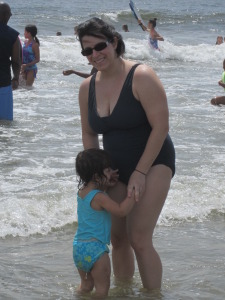 How long have you been on this journey?
How long have you been on this journey?
I discovered EM2WL in May 2012. It’s been a long journey with both ups and downs, but there is no turning back for me. It took me a while to trust the process and I’m so happy that I stuck in there. Luckily for me, I have a lot of patience, which is key with this lifestyle. Yes, lifestyle. It is not a quick fix or a diet. It’s a way of life. If you like food, like most people do, then you will like EM2WL.
When did you first learn that you needed to eat more to reach your goals?
Well my story is a bit of a lengthy one, but I think it’s one that most people can relate to. I did Weight Watchers to lose weight after both of my pregnancies. After my first pregnancy it worked great. I had lost all the weight and then some. I was also doing a lot of cardio. I was running 5 days a week and doing some light weight lifting.
After my second pregnancy, however, the weight did not come off nearly as fast with Weight Watchers. I also was not able to do my usual 5 days of running because I was diagnosed with pelvic girdle pain. It is something that I deal with to this day. I came within 8 pounds of my pre-pregnancy weight but my clothes just didn’t fit the same. I was fatter! My body composition was completely different. All of that cardio and low calorie eating came back to bite me.
A few months later I stumbled across MyfitnessPal and the EM2WL group. I watched Kiki’s and Lucia’s videos about TDEE. I was intrigued to say the least and I decided to jump right in by doing a 3 month reset. I figured if the low calorie/cardio way wasn’t working, then eating more certainly couldn’t hurt.
What was your original response?
My initial response to EM2WL was disbelief. I was shocked. How could I not have known about this? How could someone eat so much food and lose fat? I just could not wrap my head around it.
 How did others around you react about your decision to discard the usual low calorie methods for weight loss?
How did others around you react about your decision to discard the usual low calorie methods for weight loss?
I think there was some hesitation from family members, except my brother. He is a personal trainer and knew exactly what I was doing. Most people didn’t understand, but I knew it was the right thing for me and that’s what matters.
How did your body react to the initial increase in cals?
Well, I gained! I ended up doing 2 resets and gained 25 pounds in a period of about one year. Yes, I know it sounds scary but I came to the realization that I had to gain before I could lose. Most people think they lose weight because they are eating LESS, but we need to realize that you’re losing weight because at one point you ate MORE. I now tell people that I actually gained weight on purpose.
I also noticed that my nails were stronger, my hair wouldn’t fall out as much, and I wasn’t cold all the time. I also saw that even though the number on the scale was either staying the same or going up, that my inches were going down.
Did your family notice or comment on any changes once you upped your calories for a period of time?
I think it sparked some curiosity in my family members. I am definitely more muscular now than I have ever been my entire life. My husband felt my arms earlier today and was impressed with my progress.
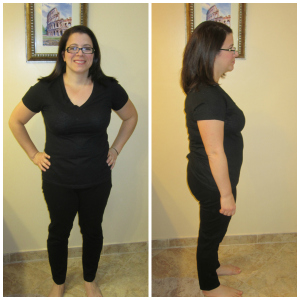 Can you describe your typical workout schedule prior to EM2WL and today?
Can you describe your typical workout schedule prior to EM2WL and today?
Prior to EM2WL I was doing an insane amount of cardio. I would run 5 days a week and do light weight lifting. By that I mean lifting no more than 5-10 pound dumbbells. And to be honest, I don’t think I could lift more than that anyway because I wasn’t eating enough.
Today I do cardio maybe once a week. Again, I suffer from pelvic girdle pain and cardio tends to aggravate that, which is actually a good thing because that means that strength training is my primary form of exercise. It helps with my pelvis. So it’s a win-win!
I lift weights 3 days a week and lift heavy. I’m midway through The New Rules of Lifting for Women and have experienced great results thus far. I am also a huge Cathe fan. I’ve done 1.5 rounds of STS before spraining my wrist this summer.
I really look forward to my workouts because I love seeing my progress. I’m at the point now where I enjoy focusing more on what my body can do versus how much weight I have lost. That stupid number on the scale doesn’t mean anything to me anymore.
In conclusion…
In conclusion, I’d like to thank Kiki, Lucia and the entire EM2WL family for the constant support. I’m so thankful that I have adopted this lifestyle. Not only for myself, but for my daughters too. They know when they see me exercising that I’m doing it so I can be strong, not so I can be skinny.

by | Dec 9, 2014 | Consistency, Metabolism Reset, Strength Training, Testimonials
 The Two Year Plan
The Two Year Plan
Hi. I’m Liane and I’m one year into a plan. I was never good at the small details but great at the big picture. This is why I came up with a two year plan but ended up flying by the seat of my pants and still, to some extent, am. But let me start at the beginning (see, flying by seat of pants).
When I was in high school, I was a serious athlete. I played three seasons of sport (field hockey, basketball and softball) and had the body that went with this. In the 80s, the muscular with some body fat body wasn’t something to have as a teen (then again, it seems to never have been the body to have). I thought my butt was too large, my tummy too large and I hated my muscular calves. I wanted my best friend’s tall lithe body. I look back on those pictures and wish I had that body again! I was so cute and fit (my tummy was just lightly rounded but I couldn’t see it). BUT, I didn’t diet. It wasn’t big in my group of friends who all seemed to just eat.
The summer after I graduated I went and worked as a pool-side cocktail waitress in a bathing suit at a resort. Talk about horrible. I was a late bloomer and working with these college women who were much more developed. At the same time I started drinking alcohol and eating to deal with the emotions I was feeling, being away from home. I gained 20 lbs in that summer. Yup, the freshmen 15+ before even becoming a university freshmen. Ugh. I began to play Division 1 field hockey at university and along with eating less meat and more veg, I lost the entire 20 lbs during that year. I felt good about myself. I hadn’t starved myself but cut out a few small things. And then my sophomore year came and a new coach. She made us all get our body fat taken by caliper. I was told that at 22%, I would have to lose a lot of weight – I was fat. Yup, not just asking me to eat a bit less to get a lower body fat percentage but that I was fat and to lose weight. All my insecurities came back. And so I began to starve myself. I probably ate between 800-1000 calories most days, though more on weekends. As you can imagine, in the next three years I did lose a lot of weight but my hockey performance declined a lot. My coach had ruined me. But I was skinny.
 Throughout my 20s, I was constantly trying to keep that very skinny body shape. I would under eat, workout for hours and smoke. Yuck. But I was skinny for the most part.
Throughout my 20s, I was constantly trying to keep that very skinny body shape. I would under eat, workout for hours and smoke. Yuck. But I was skinny for the most part.
When I wasn’t doing these things, my weight would balloon. And as I got older it got harder to go between heavier and skinnier. The worst was when I ended up tearing my ACL while playing rugby. I couldn’t exercise for months in the same way and I ate because I was unhappy. So I gained again.
Up, down, up down, never actually learning how to eat the right way. But I kept around a decent body weight and I doubt anyone would have ever called me ‘fat’ (though I felt that way). In 2004, I moved to London for a job. In the first few months, I lost weight despite drinking lots of beer with my new field hockey teammates and felt fantastic at my dad and stepmom’s wedding. I didn’t really eat a lot because I was a bit broke and I was walking everywhere as the transportation was expensive (and I didn’t have a paycheck right away). I then met my to be husband. He is a born and bred Londoner. And he loves food. He was the first guy I met who told me to eat more, that I was too skinny and that he couldn’t understand women who ate salads only. He loved my bum and hoped that I would get curvier.
 That led to the two of us sharing our love of food and cooking. He taught me Indian dishes (as that was his background) and I showed him how to barbecue. Over the next couple of years, we both slowly gained weight, though I did more so due to eating his size portions. I called it my boyfriend weight. But I was happy. I didn’t even care about losing weight before I got married though I was sad to have a tummy in my wedding pics (Indian style wedding so tummy showed!) Eventually, I actually weighed myself and saw that I was 170 lbs. Holy cow. This was by far the heaviest I had been at 5’6″. I found MFP and lost 20 lbs quite quickly (I put myself in for a 2 lb a week weight loss). I ate very little, which felt natural to me. A few years later (and a year ago), I saw pics of myself looking quite fat faced and decided to weight myself. 165. Darn it. Gained weight again! Back to MFP where I quickly lost 5 lbs.
That led to the two of us sharing our love of food and cooking. He taught me Indian dishes (as that was his background) and I showed him how to barbecue. Over the next couple of years, we both slowly gained weight, though I did more so due to eating his size portions. I called it my boyfriend weight. But I was happy. I didn’t even care about losing weight before I got married though I was sad to have a tummy in my wedding pics (Indian style wedding so tummy showed!) Eventually, I actually weighed myself and saw that I was 170 lbs. Holy cow. This was by far the heaviest I had been at 5’6″. I found MFP and lost 20 lbs quite quickly (I put myself in for a 2 lb a week weight loss). I ate very little, which felt natural to me. A few years later (and a year ago), I saw pics of myself looking quite fat faced and decided to weight myself. 165. Darn it. Gained weight again! Back to MFP where I quickly lost 5 lbs.
But then I began to read more in the forums. Some women were posting about eating more, especially as they didn’t have a lot of weight to lose, which I didn’t. I wanted to get to 145 minimally, so I went with 1 lb a week. Lost some weight and then went to 1/2 lb weight loss goals. I was doing some weight lifting on the machines which made me feel like I was getting a bit stronger. My input of calories slowly went up to 1900. And then I just stayed there. It was frustrating. I wasn’t really losing a lot of weight, but the ladies I friended encouraged me to read more and take my time. I eventually got to the EM2WL group on MFP and it was there that I finally figured out how to do this. I didn’t want to lose weight only to gain it again. I was 45, darn it, and I wanted to start eating for my lifestyle while also losing some body fat.
 I joined the website forums and began to post. I started doing Stronglifts 5×5 as it seemed like a great programme. I lost those final few pounds to get to 145 as I was eating more (who knew?) and I decided that I would try to figure out my true TDEE so I could do a healthy cut to get to my final goal weight of 140.
I joined the website forums and began to post. I started doing Stronglifts 5×5 as it seemed like a great programme. I lost those final few pounds to get to 145 as I was eating more (who knew?) and I decided that I would try to figure out my true TDEE so I could do a healthy cut to get to my final goal weight of 140.
I’m still in the midst of doing this. I’ve slowly added 100-200 calories and held at that level for a month at a time. I’ve had setbacks such as breaking a rib and getting a major chest infection which has influenced how much and what I could do as workouts. But I’ve held strong. I’m now eating the way I hope to for life – I haven’t given up a single food but I’m trying to keep my protein intake a bit higher (to keep my muscles) and watch my portion size. Amazingly enough, I’m eating almost at dinner some nights what I used to eat all day (around 1200 calories). I’m still in the midst of figuring out my TDEE (I’m at 2400 calories currently) and once I get to the point where I am gaining weight steadily, then I’ll know it’s time for a small cut of 10-15%.
I’m one year into my two year plan. I didn’t know how to get to where I was going, but now, I have more of an idea of what I need to do. I’m no longer really listening to the scale in the same way I used to. For me, it’s a tool to figure out my TDEE but not to figure out if my body is where it needs to be. I’m using measurements and my mirror as my guides. I’ll never been a fitness model, nor do I want to be one, so I’ll always carry a bit more body fat than others. I want to be able to have pizza and beer while still feeling fit. I want to still be playing field hockey at age 50 (I’m almost 46 and going strong on a team in London). And, if I live to my 90s like my grandmothers did, I want to be in the best health that I can, with strong bones from lifting and eating well. Yeah, those are good goals.
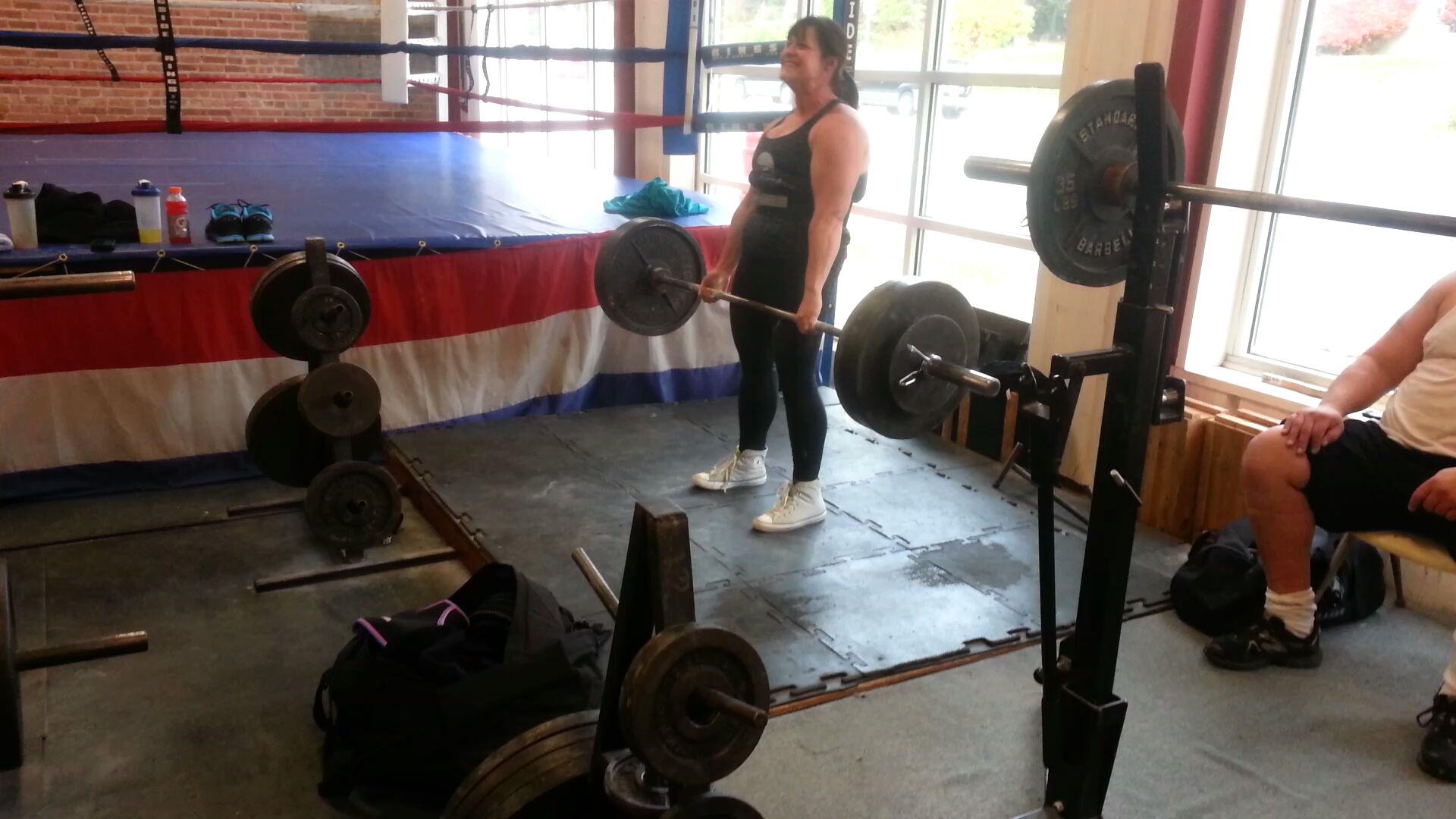
by | Nov 19, 2013 | Building Muscle, Fat Loss / Cutting, Motivation, Q & A, Strength Training
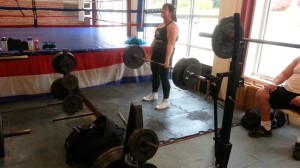 If you are new to strength training, you may be confused by some of the terms that get thrown around. Questions that we frequently get asked is about the difference between compound vs isolation exercises.
If you are new to strength training, you may be confused by some of the terms that get thrown around. Questions that we frequently get asked is about the difference between compound vs isolation exercises.
- What is the difference between compound and isolation movements?
- Are compound or isolation exercises preferred?
- When should I incorporate these movements into my strength training regimen?
In general, compound exercises are those weighted movements that involve multiple major muscle groups and involve movement at multiple joints of the body. Generally speaking, they promote “functional fitness” by simulating real life activities. Examples of compound exercises would be the squat, the deadlift, the row, and the bench press. There are multiple versions of each of these exercises.
 In contrast, isolation exercises generally work only one muscle group and involve movement at only one joint. Often, isolation exercises are performed on machines. Typical examples include the biceps curl or the quadriceps extension.
In contrast, isolation exercises generally work only one muscle group and involve movement at only one joint. Often, isolation exercises are performed on machines. Typical examples include the biceps curl or the quadriceps extension.
A prime example of a compound exercise is the deadlift. Although many people think of the deadlift as a lower body exercise, a number of other muscles are used as stabilizer muscles in this exercise. The biceps, abdominal muscles, and trapezius are a few of the upper body muscles which are targeted. Deadlifts are a prime example of one exercise working nearly every muscle fiber in the body!
Compound Movements have a number of benefits:
- Because more muscle fibers from large muscle groups are being recruited, these movements burn more calories
- Are often seen as a more effective use of time, since a full body workout can be completed with only a few exercises.
- Mimic movements that are used in daily life, thereby enhancing functional fitness.
- Provide cardiovascular conditioning and benefits
- Provide sport-specific benefits such as improved mobility, coordination and balance
- Trigger greater release of muscle-building hormones
- Reduce risk of over-training since fewer training sessions are required to target muscle groups
If your primary goal is fat loss, doing moderate to high repetitions of compound movements will provide a great calorie burn and target your large muscle groups, thereby stimulating the metabolism. It should be stressed that compound movements do prevent a greater risk for injury if done incorrectly. Learning proper form should be a major consideration. If you have access to a personal trainer or someone who is an experienced lifter, perhaps ask them to demonstrate proper form or watch your lifts. Another good idea is to video your lifts and check your form. If you are very new to lifting, checking out examples of exercises on YouTube is a great idea.
For those seeking to gain muscle or increase strength, heavy compound movements in the lower repetition range (3-8) will provide an environment for this as well. However, both those seeking to lose fat or gain muscle will benefit from including some isolation exercises.
Benefits of Isolation Movements:
- reduces risk of injury -increases blood volume to muscle
- initiates growth
- correct imbalances which may result from or lead to injury
- increases size and bulk of muscle, and provide shape to the muscle
After fast-twitch muscle fibers have been depleted through heavy compound work, isolation exercises can be used to maximize blood volume to the muscle, thereby initiating the growth process.

Heavy Lifting Makes us happy!
If you are new to strength training, you will probably want to structure your program around some good, basic compound exercises such as the bench press, row, deadlift and squat. Start light, learn proper form, and gradually increase the weight being lifted. Generally speaking, a well-structured lifting program will focus on compound movements first and then add in complementary isolation exercises to correct imbalances and provide an opportunity for hypertrophy. Even beginners will benefit from adding in some isolation exercises to their strength training program. These exercises should be ones that are directly related to the compound lifts.
Below are some examples of isolation exercises that will have the most carryover to your main lifts.
Bench Press
- triceps extensions
- front raises
- side raises
- rope pull downs
Deadlifts
- bicep curls
- hip thrusts
- leg extensions
- glute ham raise
Squats
- leg extensions
- reverse hyper
- leg curls Rows-bicep curls
For the majority of people looking to lose fat, gain muscle and improve functional fitness, a well rounded lifting program will focus first on compound lifts and then add in isolation movements to increase hypertrophy, prevent injury, and correct imbalances. Using both compound and isolation exercises will get you the results you are seeking! The following example should provide a good idea of how to combine both compound and isolation exercises for an effective workout that will provide an environment for building muscle, burning fat, and increasing strength and overall conditioning. These workouts should be able to be completed in about an hour. For best results, find a weight that challenges you. If you can complete more than the prescribed number of repetitions, you will want to increase the weight.
Monday: Legs and Glutes
Wednesday: Upper Body
Friday: Legs and Back
Becca is a busy wife and homeschooling mother to five children ages 5 to 13. About three years ago, she embarked on a journey to health and fitness that resulted in the loss of approximately 100 pounds. Today, she is a competitive powerlifter and strongwoman who loves ice cream and deadlifts. As an ISSA certified personal trainer, she is passionate about helping women to get started on a lifestyle of strength and fitness.
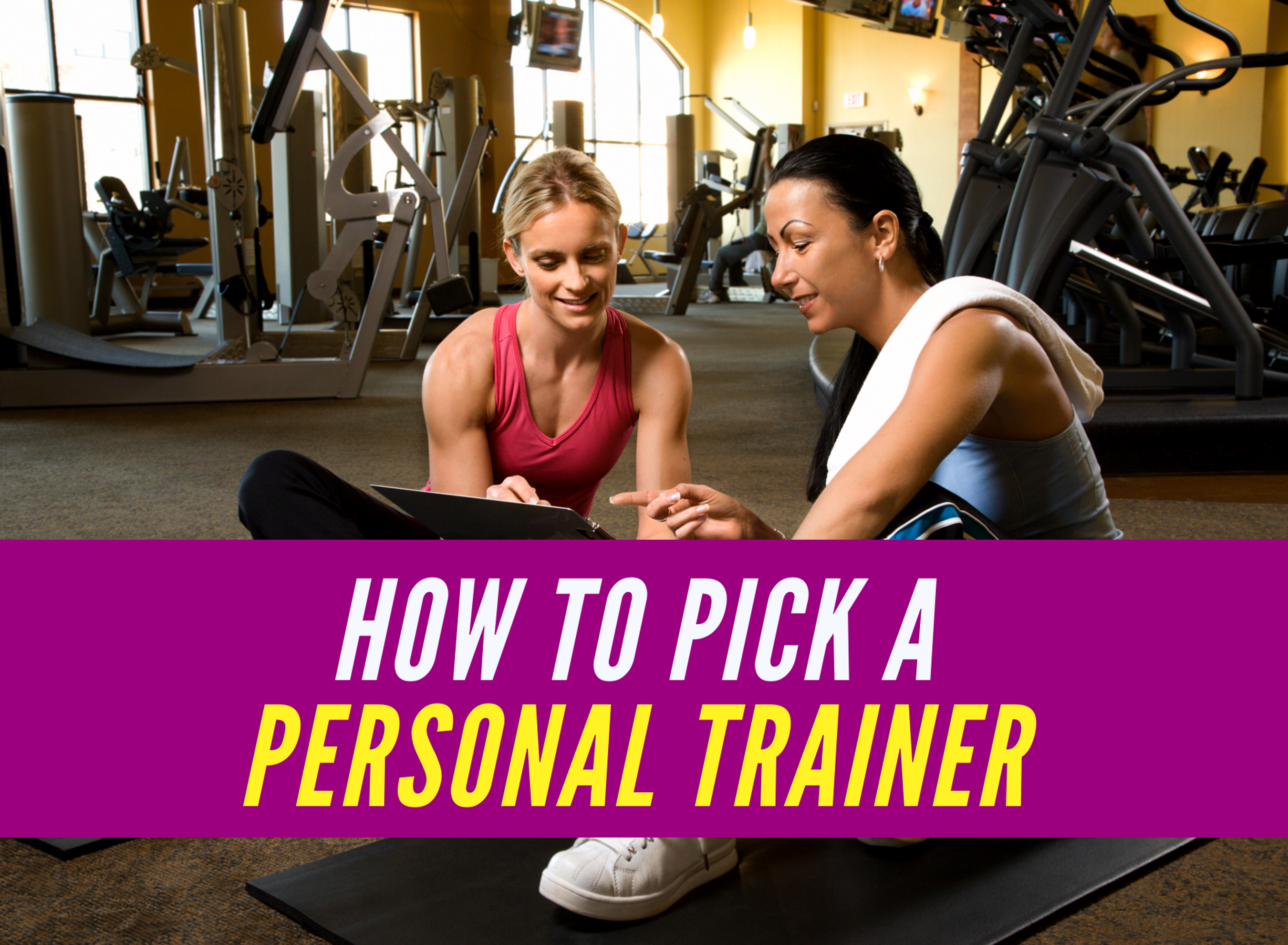
by EM2WL | Jun 30, 2012 | Building Muscle, Fitness Cycles (Periodization), Increasing calories, Strength Training
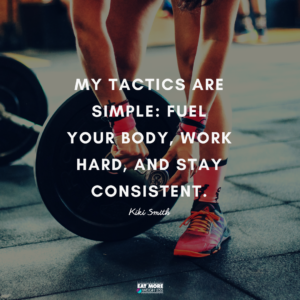 How to Pick a Personal Trainer…
How to Pick a Personal Trainer…
I’ve noticed a trend…
Many people make the decision to follow the EM2WL lifestyle, and then head out to seek a local Certified Personal Trainer to assist them on their journey. However, merely days into the training (sometimes even after the first session) they will come back to us in a state of confusion, because they have received conflicting information and don’t know which to follow. As a trainer, I’ve made a couple of observations of how some (including myself) do things differently from most. Knowing the different schools of thought can help you to interview & pick the personal trainer that is best for you.
Work Harder
Most trainers know that they have a limited amount of time to make an impact. The client needs to see results, and they need to see them fast, or else they are quickly moving on. Most of the “stay the course,” “be consistent,” “trust the process” lines that we throw out there are not often used in mainstream training, because, quite frankly, clients don’t want to hear it. A personal trainer that wants a client to keep coming back for more has to achieve a LOT in a small amount of time, or at least enough to make an impact. So one way to do this is to work you very hard within the first few sessions, so that you can see that you work much harder with them, than you did before they came into the picture. Often, a bit more cardio than necessary may be thrown in for good measure, to make sure that you feel “worked.”
Eat Less
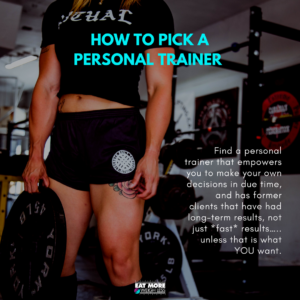 Another way a personal trainer can make that impact, is by telling you that your current cal intake (whatever it may be) is too high. This lowering of cals is almost a guaranteed drop in lbs within the first week or so, simply because the cals were high(er), and now they’re not. Having such a significant drop in lbs within the first week or so will buy the trainer MUCH more time with that client, because they have earned their trust. If they can quickly get you to drop weight, then long after you’ve stopped going to them, and gained the weight back, (because you’ve gone back to eating normal, and working out in your regular manner) you’ll always remember how you had “better” results when you worked with them. You’ll go back (at your higher cal intake) they will have you drop calories (again), while kicking your butt with the workouts. So as long as you stay with them, and dependent on them, you both “win.”
Another way a personal trainer can make that impact, is by telling you that your current cal intake (whatever it may be) is too high. This lowering of cals is almost a guaranteed drop in lbs within the first week or so, simply because the cals were high(er), and now they’re not. Having such a significant drop in lbs within the first week or so will buy the trainer MUCH more time with that client, because they have earned their trust. If they can quickly get you to drop weight, then long after you’ve stopped going to them, and gained the weight back, (because you’ve gone back to eating normal, and working out in your regular manner) you’ll always remember how you had “better” results when you worked with them. You’ll go back (at your higher cal intake) they will have you drop calories (again), while kicking your butt with the workouts. So as long as you stay with them, and dependent on them, you both “win.”
Business is business
I can’t knock the trainers that use these methods, because, quite honestly, they are very lucrative. But, ethically, I just can’t do it. I don’t mind showing a person that they can work harder than they have been, but I’d never recommend more exercise, or less food, than is necessary. My goal as a trainer (and the type of trainer I suggest you look for when interviewing) is to allow a person to develop a plan of attack that will fit into their lives, and that will apply long after our session is over. A client needs to become self-sufficient, and know what to do when the trainer is no longer around. I have no desire to become a persons fad diet.
The true cost
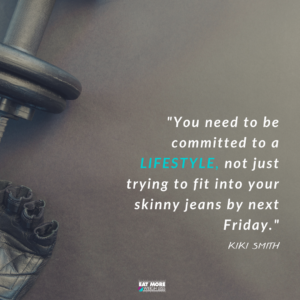 Although it’s harder to look a client in the eye and tell them to do the opposite of everything that they’ve read, and that they shouldn’t expect any results from working with me for at least the first month, it sets the standard for our relationship right off the bat. I let them know that I will not withhold any “secrets” from them in what they need to reach their goals, my tactics are simple: fuel your body, work hard, and stay consistent.
Although it’s harder to look a client in the eye and tell them to do the opposite of everything that they’ve read, and that they shouldn’t expect any results from working with me for at least the first month, it sets the standard for our relationship right off the bat. I let them know that I will not withhold any “secrets” from them in what they need to reach their goals, my tactics are simple: fuel your body, work hard, and stay consistent.
The client needs to be committed to a lifestyle, not just trying to fit into their skinny jeans by next Friday.
There are enough trainers out there that can help them accomplish that, but I am trying to help them fit into their skinny jeans for the rest of their lives. They will leave our sessions armed with info to help themselves and others around them. I may lose a bit more peeps that way, who aren’t willing to wait, but that is fine, because I need to see that the person wants what I’m trying to give, with the same passion that I give it.
Find a personal trainer that empowers you to make your own decisions in due time, and has former clients that have had long-term results, not just *fast* results….. unless that is what YOU want.





 How did others around you react about your decision to discard the usual low calorie methods for weight loss?
How did others around you react about your decision to discard the usual low calorie methods for weight loss?


 Throughout my 20s, I was constantly trying to keep that very skinny body shape. I would under eat, workout for hours and smoke. Yuck. But I was skinny for the most part.
Throughout my 20s, I was constantly trying to keep that very skinny body shape. I would under eat, workout for hours and smoke. Yuck. But I was skinny for the most part.
 I joined the website forums and began to post. I started doing Stronglifts 5×5 as it seemed like a great programme. I lost those final few pounds to get to 145 as I was eating more (who knew?) and I decided that I would try to figure out my true TDEE so I could do a healthy cut to get to my final goal weight of 140.
I joined the website forums and began to post. I started doing Stronglifts 5×5 as it seemed like a great programme. I lost those final few pounds to get to 145 as I was eating more (who knew?) and I decided that I would try to figure out my true TDEE so I could do a healthy cut to get to my final goal weight of 140.


 In contrast, isolation exercises generally work only one muscle group and involve movement at only one joint. Often, isolation exercises are performed on machines. Typical examples include the biceps curl or the quadriceps extension.
In contrast, isolation exercises generally work only one muscle group and involve movement at only one joint. Often, isolation exercises are performed on machines. Typical examples include the biceps curl or the quadriceps extension.

 How to Pick a Personal Trainer…
How to Pick a Personal Trainer… Another way a personal trainer can make that impact, is by telling you that your current cal intake (whatever it may be) is too high. This lowering of cals is almost a guaranteed drop in lbs within the first week or so, simply because the cals were high(er), and now they’re not. Having such a significant drop in lbs within the first week or so will buy the trainer MUCH more time with that client, because they have earned their trust. If they can quickly get you to drop weight, then long after you’ve stopped going to them, and gained the weight back, (because you’ve gone back to eating normal, and working out in your regular manner) you’ll always remember how you had “better” results when you worked with them. You’ll go back (at your higher cal intake) they will have you drop calories (again), while kicking your butt with the workouts. So as long as you stay with them, and dependent on them, you both “win.”
Another way a personal trainer can make that impact, is by telling you that your current cal intake (whatever it may be) is too high. This lowering of cals is almost a guaranteed drop in lbs within the first week or so, simply because the cals were high(er), and now they’re not. Having such a significant drop in lbs within the first week or so will buy the trainer MUCH more time with that client, because they have earned their trust. If they can quickly get you to drop weight, then long after you’ve stopped going to them, and gained the weight back, (because you’ve gone back to eating normal, and working out in your regular manner) you’ll always remember how you had “better” results when you worked with them. You’ll go back (at your higher cal intake) they will have you drop calories (again), while kicking your butt with the workouts. So as long as you stay with them, and dependent on them, you both “win.” Although it’s harder to look a client in the eye and tell them to do the opposite of everything that they’ve read, and that they shouldn’t expect any results from working with me for at least the first month, it sets the standard for our relationship right off the bat. I let them know that I will not withhold any “secrets” from them in what they need to reach their goals,
Although it’s harder to look a client in the eye and tell them to do the opposite of everything that they’ve read, and that they shouldn’t expect any results from working with me for at least the first month, it sets the standard for our relationship right off the bat. I let them know that I will not withhold any “secrets” from them in what they need to reach their goals,
Recent Comments